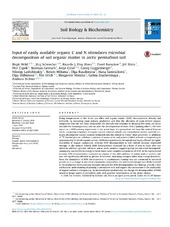Input of easily available organic C and N stimulates microbial decomposition of soil organic matter in arctic permafrost soil
| dc.contributor.author | Wild, Birgit | eng |
| dc.contributor.author | Schnecker, Jörg | eng |
| dc.contributor.author | Alves, Ricardo J. Eloy | eng |
| dc.contributor.author | Barsukov, Pavel | eng |
| dc.contributor.author | Bárta, Jiří | eng |
| dc.contributor.author | Čapek, Petr | eng |
| dc.contributor.author | Gentsch, Norman | eng |
| dc.contributor.author | Gittel, Antje | eng |
| dc.contributor.author | Guggenberger, Georg | eng |
| dc.contributor.author | Lashchinskiy, Nikolay | eng |
| dc.contributor.author | Mikutta, Robert | eng |
| dc.contributor.author | Rusalimova, Olga | eng |
| dc.contributor.author | Šantrůčková, Hana | eng |
| dc.contributor.author | Shibistova, Olga | eng |
| dc.contributor.author | Urich, Tim | eng |
| dc.contributor.author | Watzka, Margarete | eng |
| dc.contributor.author | Zrazhevskaya, Galina | eng |
| dc.contributor.author | Richter, Andreas | eng |
| dc.date.accessioned | 2015-03-18T09:52:01Z | |
| dc.date.available | 2015-03-18T09:52:01Z | |
| dc.date.issued | 2014-08 | eng |
| dc.identifier.issn | 0038-0717 | en_US |
| dc.identifier.uri | http://hdl.handle.net/1956/9567 | |
| dc.description.abstract | Rising temperatures in the Arctic can affect soil organic matter (SOM) decomposition directly and indirectly, by increasing plant primary production and thus the allocation of plant-derived organic compounds into the soil. Such compounds, for example root exudates or decaying fine roots, are easily available for microorganisms, and can alter the decomposition of older SOM (“priming effect”). We here report on a SOM priming experiment in the active layer of a permafrost soil from the central Siberian Arctic, comparing responses of organic topsoil, mineral subsoil, and cryoturbated subsoil material (i.e., poorly decomposed topsoil material subducted into the subsoil by freeze–thaw processes) to additions of 13C-labeled glucose, cellulose, a mixture of amino acids, and protein (added at levels corresponding to approximately 1% of soil organic carbon). SOM decomposition in the topsoil was barely affected by higher availability of organic compounds, whereas SOM decomposition in both subsoil horizons responded strongly. In the mineral subsoil, SOM decomposition increased by a factor of two to three after any substrate addition (glucose, cellulose, amino acids, protein), suggesting that the microbial decomposer community was limited in energy to break down more complex components of SOM. In the cryoturbated horizon, SOM decomposition increased by a factor of two after addition of amino acids or protein, but was not significantly affected by glucose or cellulose, indicating nitrogen rather than energy limitation. Since the stimulation of SOM decomposition in cryoturbated material was not connected to microbial growth or to a change in microbial community composition, the additional nitrogen was likely invested in the production of extracellular enzymes required for SOM decomposition. Our findings provide a first mechanistic understanding of priming in permafrost soils and suggest that an increase in the availability of organic carbon or nitrogen, e.g., by increased plant productivity, can change the decomposition of SOM stored in deeper layers of permafrost soils, with possible repercussions on the global climate. | en_US |
| dc.language.iso | eng | eng |
| dc.publisher | Elsevier | en_US |
| dc.rights | Attribution CC BY | eng |
| dc.rights.uri | http://creativecommons.org/licenses/by/3.0/ | eng |
| dc.subject | Priming | eng |
| dc.subject | Organic matter decomposition | eng |
| dc.subject | Phospholipid fatty acid (PLFA) | eng |
| dc.subject | Tundra | eng |
| dc.subject | Permafrost | eng |
| dc.title | Input of easily available organic C and N stimulates microbial decomposition of soil organic matter in arctic permafrost soil | en_US |
| dc.type | Peer reviewed | |
| dc.type | Journal article | |
| dc.date.updated | 2015-03-04T10:13:59Z | en_US |
| dc.description.version | publishedVersion | en_US |
| dc.rights.holder | Copyright 2014 The Authors. Published by Elsevier Ltd. This is an open access article under the CC BY license ( http://creativecommons.org/licenses/by/3.0/ ) | en_US |
| dc.identifier.doi | https://doi.org/10.1016/j.soilbio.2014.04.014 | |
| dc.identifier.cristin | 1161389 | |
| dc.source.journal | Soil Biology and Biochemistry | |
| dc.source.40 | 75 | |
| dc.source.pagenumber | 143-151 | |
| dc.relation.project | Norges forskningsråd: 179560 | |
| dc.subject.nsi | VDP::Agriculture and fisheries science: 900::Agricultural sciences: 910::Agricultural technology: 916 | en_US |
| dc.subject.nsi | VDP::Landbruks- og fiskerifag: 900::Landbruksfag: 910::Landbruksteknologi: 916 | nob |

